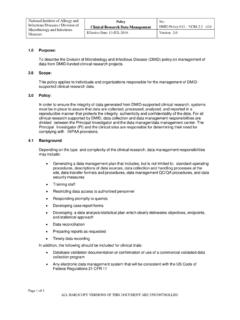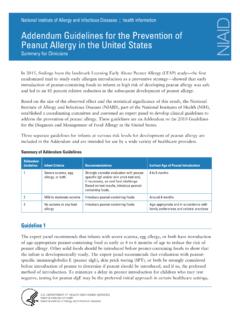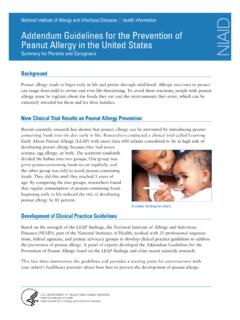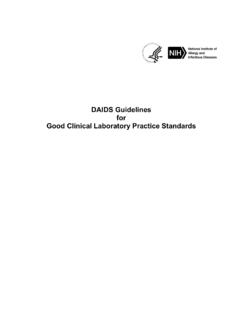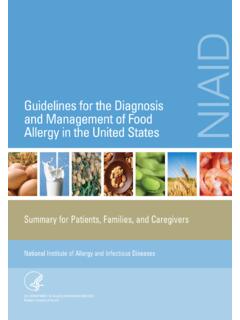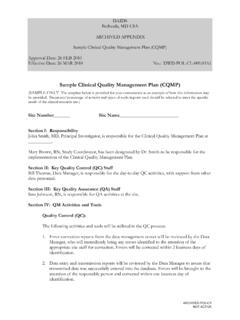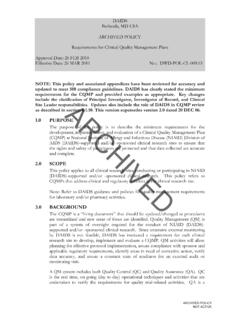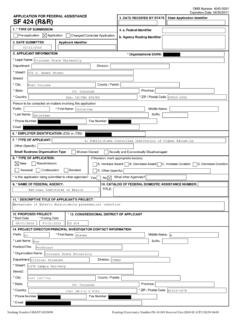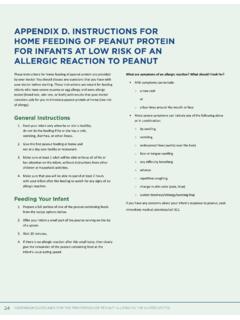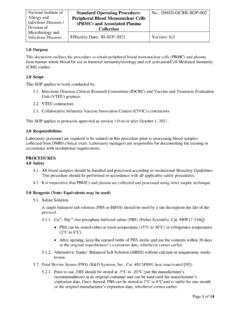Transcription of Addendum Guidelines for the Prevention of Peanut Allergy ...
1 Addendum Guidelines for the Prevention of Peanut Allergy in the United StatesReport of the NIAID-Sponsored Expert Panel3 Addendum Guidelines FOR THE Prevention OF Peanut Allergy IN THE UNITED STATESADDENDUM Guidelines FOR THE Prevention OF Peanut Allergy IN THE UNITED STATES: REPORT OF THE NATIONAL INSTITUTE OF Allergy AND INFECTIOUS DISEASES SPONSORED EXPERT PANEL Alkis Togias, MD,a Susan F. Cooper, MSc,a, * Maria L. Acebal, JD,b Amal Assa ad, MD,c James R. Baker, Jr, MD,d Lisa A. Beck, MD,e Julie Block,f Carol Byrd-Bredbenner, PhD, RD, FAND,g Edmond S. Chan, MD, FRCPC,h Lawrence F. Eichenfield, MD,i David M. Fleischer, MD,j George J. Fuchs III, MD,k Glenn T. Furuta, MD,l Matthew J. Greenhawt, MD, MBA, MSc,j Ruchi S. Gupta, MD, MPH,m Michele Habich, DNP, APN/CNS, CPN,n Stacie M. Jones, MD,o Kari Keaton,p Antonella Muraro, MD, PhD,q Marshall Plaut, MD,a Lanny J. Rosenwasser, MD,r Daniel Rotrosen, MD,a Hugh A.
2 Sampson, MD,s Lynda C. Schneider, MD,t Scott H. Sicherer, MD,u Robert Sidbury, MD, MPH,v Jonathan Spergel, MD, PhD,w David R. Stukus, MD,x Carina Venter, PhD, RD,y and Joshua A. Boyce, MDzBethesda, Md; McLean, Va; Cincinnati and Columbus, Ohio; Ann Arbor, Mich; San Rafael and San Diego, Calif; New Brunswick, NJ; Vancouver, British Columbia, Canada; Aurora, Colo; Lexington, Ky; Chicago and Winfield, Ill; Little Rock, Ark; Rockville, Md; Padua, Italy; Kansas City, Mo; New York, NY; Boston, Mass; Seattle, Wash; and Philadelphia, PaBackground: Food Allergy is an important public health problem because it affects children and adults, can be severe and evenlife-threatening, and may be increasing in prevalence. Beginning in 2008, the National Institute of Allergy and Infectious Diseases,working with other organizations and advocacy groups, led the development of the first clinical Guidelines for the diagnosis andmanagement of food Allergy .
3 A recent landmark clinical trial and other emerging data suggest that Peanut Allergy can be preventedthrough introduction of Peanut -containing foods beginning in : Prompted by these findings, along with 25 professional organizations, federal agencies, and patient advocacy groups, the National Institute of Allergy and Infectious Diseases facilitated development of Addendum Guidelines to specifically address the Prevention of Peanut : The Addendum provides 3 separate Guidelines for infants at various risk levels for the development of Peanut Allergy and is intended for use by a wide variety of health care providers. Topics addressed include the definition of risk categories, appropriate use of testing (specific IgE measurement, skin prick tests, and oral food challenges), and the timing and approaches for introduction of Peanut -containing foods in the health care provider s office or at home. The Addendum Guidelines provide the background, rationale, and strength of evidence for each : Guidelines have been developed for early introduction of Peanut -containing foods into the diets of infants at various risk levels for Peanut words: Food, Peanut , Allergy , Prevention , guidelines4 Addendum Guidelines FOR THE Prevention OF Peanut Allergy IN THE UNITED STATESFrom the National Institute of Allergy and Infectious Diseases, Bethesda, Md;a the Board of Directors, Food Allergy Research & Education, McLean;b the Division of Allergy and Immunology, Cincinnati Children s Hospital Medical Center, University of Cincinnati;c Food Allergy Research & Education, McLean, and the Division of Allergy and Clinical Immunology, University of Michigan Health System, Ann Arbor;d the Department of dermatology , University of Rochester Medical Center;e the National Eczema Association, San Rafael.
4 F the Department of Nutritional Sciences, Rutgers University, New Brunswick;g the Division of Allergy and Immunology, Department of Pediatrics, BC Children s Hospital, University of British Columbia, Vancouver;h the Departments of dermatology and Pediatrics, University of California, San Diego School of Medicine, Rady Children s Hospital, San Diego;i the Section of Allergy and Immunology, Department of Pediatrics, Children s Hospital Colorado, University of Colorado Denver School of Medicine, Aurora;j the Division of Gastroenterology, Hepatology, and Nutrition, Department of Pediatrics, University of Kentucky College of Medicine, Kentucky Children s Hospital, Lexington;k the Digestive Health Institute, Children s Hospital Colorado, Aurora, and the Section of Pediatric Gastroenterology, University of Colorado Denver School of Medicine, Aurora, Colo;l the Division of Academic General Pediatrics and Primary Care, Department of Pediatrics, and the Ann and Robert H.
5 Lurie Children s Hospital of Chicago, Northwestern University Feinberg School of Medicine, Chicago;m Northwestern Medicine, Central DuPage Hospital,Winfield;n the Division of Allergy and Immunology, Department of Pediatrics, University of Arkansas for Medical Sciences, Arkansas Children s Hospital, Little Rock;o Metro DC Food Allergy Support Group, Rockville;p the Food Allergy Referral Centre, Department of Women and Child Health, Padua University Hospital;q University of Missouri-Kansas City School of Medicine, Kansas City;r the Division of Allergy and Immunology, Department of Pediatrics,s and the Division of Pediatric Allergy and Immunology, Icahn School of Medicine at Mount Sinai, New York;u the Division of Allergy and Immunology, Boston Children s Hospital;t the Department of Pediatrics, Division of dermatology , Seattle Children s Hospital, University of Washington School of Medicine, Seattle;v the Division of Allergy and Immunology, Department of Pediatrics, Children s Hospital of Philadelphia, Perelman School of Medicine at University of Pennsylvania, Philadelphia;w the Department of Pediatrics, Section of Allergy and Immunology, Nationwide Children s Hospital, Ohio State University College of Medicine, Columbus;x the Division of Allergy and Immunology, Cincinnati Children s Hospital Medical Center;y and the Departments of Medicine and Pediatrics, Harvard Medical School, on behalf of the American Academy of Allergy , Asthma & Immunology; American College of Allergy , Asthma & Immunology; Canadian Society of Allergy and Clinical Immunology; Society for Pediatric dermatology ; World Allergy Organization; and Society of Pediatric Nurses.
6 Copublished in the Journal of Allergy and Clinical Immunology; Annals of Allergy , Asthma & Clinical Immunology; Allergy , Asthma & Clinical Immunology; World Allergy Organization Journal; Pediatric dermatology ; and the Journal of Pediatric of potential conflict of interest: A. Assa ad received travel support from the American College of Allergy , Asthma & Immunology (ACAAI); was an elected member of the Board of Directors for the American Academy of Allergy , Asthma, & Immunology (AAAAI) from March 2012 to March 2016; has consultant arrangements with Aimmune; is employed by Cincinnati Children s Hospital Medical Center; has received grants from DBV Technologies, Aimmune, Stanford Foundation, TEVA Pharmaceuticals, GlaxoSmithKline, the National Institutes of Health (NIH), Astellas, and Food Allergy Research & Education (FARE); and has received payment for lectures from the ACAAI. C. Byrd-Bredbenner and G.
7 J. Fuchs III have received travel support from the NIH/National Institute of Allergy and Infectious Disease (NIAID). E. S. Chan has received travel support from the NIAID, has received grants from DBV Technologies, and has received payment for lectures from Pfizer, Sanofi, Mead Johnson, and Nestle. D. M. Fleischer has received travel support from the NIAID; is a board member for the National Peanut Board, the FAACT Medical Advisory Board, and the FARE Medical Advisory Board; has consultant arrangements with Adamis Pharmaceuticals Corporation, INSYS Therapeutics, DBV Technologies, Aimmune Therapeutics, Intrommune Therapeutics, and Kaleo Pharma; is employed by University Physicians; has received grants from Monsanto Company, Nestle Nutrition Institute, DBV Technologies, and Aimmune Therapeutics; has received payment for lectures from Nestle Nutrition Institute; and has received royalties from UpToDate.
8 M. J. Greenhawt has received a grant from the Agency for Healthcare Research and Quality (1K08HS024599-01, Career Development Award); has received travel support from the NIAID and the Joint Taskforce on Allergy Practice Parameters; has a board membership with the National Peanut Board; has consultant arrangements with Adamis Pharmaceuticals, the Canadian Transportation Agency, Nutricia, Nestle/Gerber, Aimmune, Kaleo Pharmaceutical, and Monsanto; is an Associate Editor for the Annals of Allergy , Asthma, and Immunology; has received payment for lectures from the ACAAI, Reach MD, Thermo Fisher Scientific, the California Society for Allergy and Immunology, Abbreviations used:CC: Coordinating CommitteeEP: Expert Panel GRADE: Grading of Recommendations Assessment, Development and EvaluationEAP: Learning Early about Peanut AllergyNIAID: National Institute of Allergy and Infectious DiseasesOFC: Oral food challengesIgE: Specific IgESPT: Skin prick test5 Addendum Guidelines FOR THE Prevention OF Peanut Allergy IN THE UNITED STATESthe Allergy and Asthma Network, the New England Society for Allergy , UCLA/Harbor Heiner Lectureship, Medscape, the Western Michigan School of Medicine, the Canadian Society of Allergy and Clinical Immunology, and the Pennsylvania Society for Allergy and Immunology.
9 R. S. Gupta has consultant arrangements with BEFORE Brands and DBV Technologies; has received grants from the NIH, FARE, and Mylan LLC; has received payment for lectures from Grand Rounds; and has received royalties from Createspace Independent Publishing Platform. S. M. Jones is on the Research Advisory Board for FARE; is on the Scientific Advisory Board for Aimmune; has consultant arrangements with Stallergenes; has received grants from the NIH/NIAID (Consortium of Food Allergy Research and Immune Tolerance Network IMPACT Trial), FARE, Aimmune Technologies, DBV Technologies, and the National Peanut Board; has received payment for lectures from the Kansas City Allergy Society, Mercy Children s Hospital, Riley Children s Hospital, Southwester Medical School Children s Medical Center, the European Academy of Allergy & Clinical Immunology, the New York Allergy & Asthma Society, the University of Iowa Paul M.
10 Seebohm Lectureship in Allergy , and the Iowa Society of Allergy , Asthma, and Immunology. A. Muraro has consultant arrangements with Meda, Novartis, and Menarini; is employed by Padua University Hospital; and has received payment for lectures from Meda and Menarini. L. J. Rosenwasser is a board member for the World Allergy Organization. H. A. Sampson has consultant arrangements with Allertein Therapeutics, Genentech/Roche, Sanofi, Stallergenes, Danone, and Merck; is employed part time as Chief Scientific Officer for DBV Technologies; has received grants from the NIAID and the Immune Tolerance Network; has received royalties from UpToDate and Elsevier; has been offered stock options in DBV Technologies; and is chairman of PhARF Award Selection Committee for Thermo Fisher. L. C. Schneider is on the Medical Advisory Board for FARE, has received a grant from DBV Technologies, and has received stock/stock options in Antera Therapeutics.
